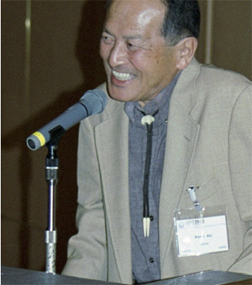
Geotimes Home | AGI Home | Information Services | Geoscience Education | Public Policy | Programs | Publications | Careers

 Like the seismic waves
he studies, Keiiti Aki’s pioneering work on the basic tenets of seismology
reaches across the planet. In recognition of his global impact, the American Geophysical
Union (AGU) and European Geosciences Union have awarded Aki their highest honors:
the William Bowie and Beno Gutenberg medals, respectively.
Like the seismic waves
he studies, Keiiti Aki’s pioneering work on the basic tenets of seismology
reaches across the planet. In recognition of his global impact, the American Geophysical
Union (AGU) and European Geosciences Union have awarded Aki their highest honors:
the William Bowie and Beno Gutenberg medals, respectively. |
Geotimes Home | AGI Home | Information Services | Geoscience Education | Public Policy | Programs | Publications | Careers |